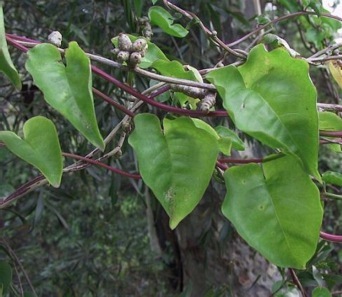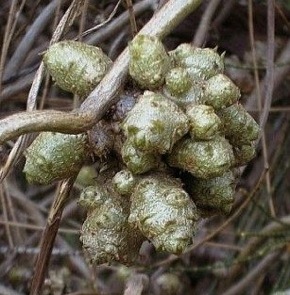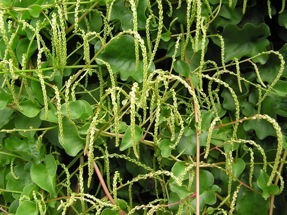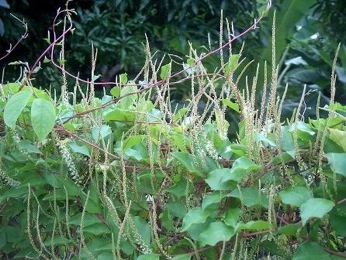Anredera cordifolia: Pest or Food Crop?
The Madeira Vine is a love/hate relationship. You will either hate it — as many land owners and governments do — or you will love it for it is a prolific source of food.
Apparently far more valued in the past than the present, the plant has quite a history. Anredera cordifolia is native to the dryer areas of South America such as Bolivia, Paraguay, Uruguay, southern Brazil and southern Argentina. It got to the United States soon after the country was founded, or the early 1800s. It was in England by 1835 and was introduced into southern Europe where it is naturalized from Portugal to Serbia. In the United States is naturalized from Florida to Texas. It’s also found in the southern half of California and in Hawaii. In South Africa, Australia, New Zealand and Hawaii it is a serious “invasive weed.” Australia (New South Wales) spends hundreds of thousands of dollars every year to fight it. (Historical note: It was often planted outside of latrines in Australia because it was thought the leaves had a laxative effect.)
Record of intentional cultivation might go back to 1821 in Florida but we aren’t sure because two plants were called the same thing. The Rev. Jedidiah Morse of Charleston Ma. then New Haven Cn., set out in 1820 to survey Indian tribes in the United States. Writing about the St. John’s River in Florida and its border lands on 15 July of that year he said:
“These light lands are not suitable for Indian corn. The best produces scarcely twenty bushels per acre. Indigo, cotton, madder, sugar cane, the mulberry tree, the date, the olive, the pomegranate, the almond, the Madeira vine, the coffee tree, beyond the twenty seventh degree, the lemon, and above all, the orange trees, thrive well, on choosing suitable soil and exposure.” (page 148, report to the Secretary of War of the United States on Indian Affairs.)
The problem is we really don’t know what Morse was referring to. In his day the common grape vine was also called the Madeira Vine, so was it an Anredera he saw or a Vitis (grape?) Natives in Florida did grow grapes, especially some escaped cultivars left over from much earlier Spanish inhabitations. However, grape production from escaped or wild grapes in Florida is iffy. Their fruiting is sporadic, often skipping many years, plus there were wild grapes growing without any tending. Cultivating a fast growing starchy root crop like the Madeira Vine, however, makes sense.
As the plant is subtropical it will survive only a light frost. From its roots it will grow some 130 feet a year, with an occasional growth spurt of three feet a week. It can have lateral stems up to 65 feet long. The vine does not have tendrils but it climbs by twisting (at eye level) lower left to upper right, the so-called Z-twist. It is interesting that most edibles climb that way whereas most toxics climb lower right to upper left, the S- twist. The Madeira Vine has long drooping flower spikes covered with tiny white blossoms (looks like their common name of Lamb’s Tails.) Their aroma ranges from apple-ish to almond-ish. One of the main identifying characteristics is large prolific clusters of tiny bulbils (sometimes called “tubers) in the air. Plant them and the new crop takes off, or spreads wildly, depending upon your view.
Not only are the underground roots (actually rhizomes) edible but the evergreen leaves as well. They are bright, shiny green on top, lighter green underneath, no hair, short petioles, about five inches long, waxy, roughly heart-shaped. The small bulbils are not edible but have been used medicinally to reduce inflammation, improve ulcers and protect the liver. They might also increase nitric oxide to the brain (see herb blurb below.)
Anredera (ah-REE-der-uh or an-RED-er-uh) is thought to come from the Spanish word Enredadra, which refers to any twining or climbing weed. Cordifolia (chord-dee-FOAL-lia) means heart-shaped leaves) As to why it is called the Madeira Vine is also unknown. One author, Edwin Menninger in his 1970 publication Flowering Vines of The World, suggest the plant first went to the island of Madeira and then back to the northern New World. There are about 12 different species of Anredera, many of them edible, and is related to Malabar Spinach, a garden vegetables in warmer climates. Incidentally the Island of Madeira is called said because in Portuguese it means “wood” from the Latin “materia.” This is because the island was once heavily wooded. That;s also where we get the word “material.”
Lastly, if you’re in southern Florida or Texas and come across a Madeira Vine with up-turned flower spikes and no ariel tubers you have A. leptostachys (syn A. vesicaria) aka Cuban Ivy. It’s edibility is similar to the Madeira Vine as is the A. baselloides. In fact, the Madeira vine is sometime mistakenly called
[stextbox id=”custom” caption=”Green Deane’s “Itemized” Plant Profile”]
IDENTIFICATION: Hairless perennial creeper, fleshy rhizome, bright green, alternate, fleshy/waxy heart-shaped leaves with reddish-brown stems. Small fragrant, cream flowers in slender drooping spikes. Tubers produced underground, bulbils on stems.
TIME OF YEAR: Depends upon location, mid-spring in Florida, summer to fall in some areas, January to May in others.
ENVIRONMENT: Edges of forest, rocky places, coastal areas, hammocks, prefers warm, moist fertile soils.
METHOD OF PREPARATION: Leaves cooked and used like spinach. Underground roots cooked, baked preferable. Can be eaten raw but the texture is gooey. Above ground bulbils (tubers) are medicinal.[/stextbox]
HERB BLURB
APeptides. 2007 Jun;28(6):1311-6. Epub 2007 Apr 27.
Ancordin, the major rhizome protein of madeira-vine, with trypsin inhibitory and stimulatory activities in nitric oxide productions. Chuang MT, Lin YS, Hou WC. St. Martin De Porres Hospital, Chiayi 600, Taiwan.
Anredera cordifolia (Ten.) Steenis, or the synonymous name of Boussingaultia baselloides or Boussingaultia gracilis var. pseudobaselloides, is a South American species of ornamental succulent vine, commonly known as the madeira-vine. The fresh leaves of madeira-vine are frequently used as vegetables. A. cordifolia is an evergreen climber that grows from fleshy rhizomes. The rhizome contained one major (23kDa) protein band under non-reducing condition in the SDS-PAGE. The first 15 amino acids in the N-terminal region of the major protein band (23kDa), named tentatively ancordin, were KDDLLVLDIGGNPVV which were highly homologous to sequences of winged bean seed protein ws-1, Medicago truncatula proteinase inhibitor, soybean trypsin inhibitor, and sporamin. By using activity stains, the ancordin showed trypsin inhibitory activity in the SDS-PAGE gel which was found not only in rhizomes but also in aerial tubers, but few in fresh leaves. The crude extracts from rhizomes of madeira-vine were directly loaded onto trypsin-Sepharose 4B affinity column. After washing with 100mM Tris-HCl buffer (pH 7.9) containing 100mM NaCl, the ancordin was eluted directly by 0.2M KC1-HC1 buffer (pH 2.0). In calculation, the purified protein exhibited 0.0428mug trypsin inhibition/mug ancordin (corresponding to 0.53 unit of TPCK-treated trypsin inhibited/mug ancordin). The purified ancordin was used to evaluate the nitric oxide productions in RAW264.7 cells in the presence of polymyxin B (poly B, 50microg/ml) to eliminate the lipopolysaccharide (LPS) contaminations. It was found that ancordin (1.25-5microg/ml) could dose-dependently (R=0.954) stimulate the nitric oxide (NO) productions (expressed as nitrite concentrations) in RAW264.7 cells without significant cytotoxicity, and kept the similar effects in NO production in 6.25microg/ml ancordin.
AnAntinociceptive effects of the tubercles of Anredera leptostachys
M. P. Tornos, M. T. Sáenzhttp, M. D. García and M. A. Fernández
Departamento de Farmacología, Facultad de Farmacia, Universidad de Sevilla, C/ Profesor García Gonzalez s/n, 41012- Seville, Spain
The tubercles of Anredera leptostachys are used as an antinociceptive and anti-inflammatory in the popular medicine of the Caribbean basin. In the present work, the anti-nociceptive and central nervous system depressant (CNS) effects of the methanolic extract from the tubercles of A. leptostachys have been evaluated. The antinociceptive activity was assayed in several experimental models in mice: acetic acid, formalin and hot plate tests. The methanolic extract (250 and 500 mg/kg) significantly and in a dose-dependent manner reduced the nociception induced by the acetic acid (P<0.001). In the hot plate test, the extract significantly increased the latency time of jump although it slightly increased the licking time. The naloxone partially reversed the antinociception of the extract in the hot plate test. In the formalin test, the methanolic extract also significantly reduced the painful stimulus but the effect was not dose-dependent. In the study of the CNS-depressant effects, the extract was found to produce a significant reduction of the exploratory capacity with both doses assayed (P<0.001). The muscular relaxation only decreased with the higher doses assayed (P<0.001). The escape instinct was also significantly reduced (P<0.001) by the two doses of the extract and both were more effective than standard drugs morphine and diazepam.





